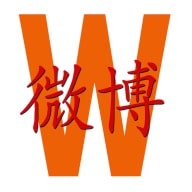China Media
“History Won’t Forget”: Chinese Reactions to Japan’s Fukushima Water Release in 5 Trending Hashtags
Furious responses from Chinese media and netizens after Japan starts releasing Fukushima water into the Pacific: “The entire world will remember what the Japanese government did this day.”
Published
2 years agoon
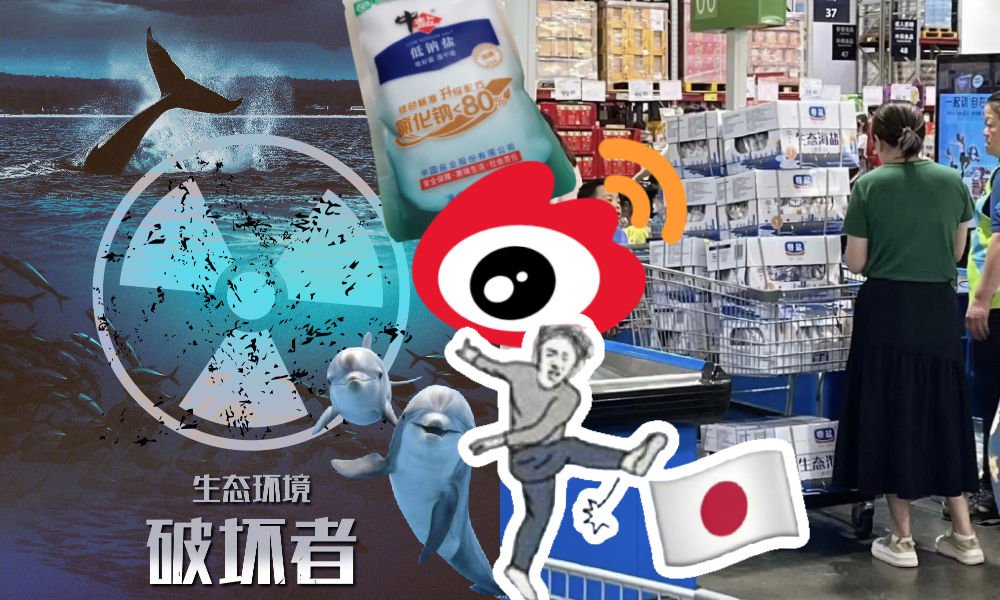
PREMIUM CONTENT
After Japan started to release the first batch of treated Fukushima water into the ocean, Chinese state media launched a strong condemnation campaign on social platforms, while netizens react with panic buying, boycotts, and waves of anti-Japanese sentiments.
Japan’s decision to commence the release of treated radioactive water from the ruined Fukushima nuclear plant on August 24 has taken center stage on Chinese social media this week.
These days, Weibo and other Chinese social media platforms saw a surge of state media slogans directed against Japan, as well as furious posts from well-known bloggers and regular netizens.
Japan will release the treated water stored in tanks at the site into the ocean over the duration of about 17 days, but that is only for this first batch. The release of all the wastewater is estimated to take about 30 years.
Japan’s plans to discharge wastewater from the Fukushima nuclear plant, which was severely damaged by the Tōhoku earthquake and tsunami on March 11 of 2011, were found to be consistent with international safety standards by the International Atomic Energy Agency earlier this year. Following the tsunami, over 1.3 million cubic meters of seawater were employed to cool the damaged reactor cores and prevent overheating.
Some scientists argue that the continued storage of cooling water in tanks, which are running out of storage, might pose a far greater risk compared to treating and diluting the water before releasing it into the ocean.
However, there is a significant range of opinions on this matter, and numerous voices oppose the intentional release of hazardous substances into the environment. Concerns are prevalent regarding the potential long-term effects on human health, wildlife, and the local fishing industry.
Foreign criticism, much seen on Twitter, that Chinese nuclear plants have allegedly released far more radiation into the sea, is ‘debunked’ by Chinese netizens by posting an image that is supposed to show the difference in the kind of water that is discharged: the ‘clean’ water (top) and the contaminated water (buttom). Instead of scientifically-backed information, the content that is mainly gaining traction these days is driven by emotions, anxiety, distrust, and nationalism.
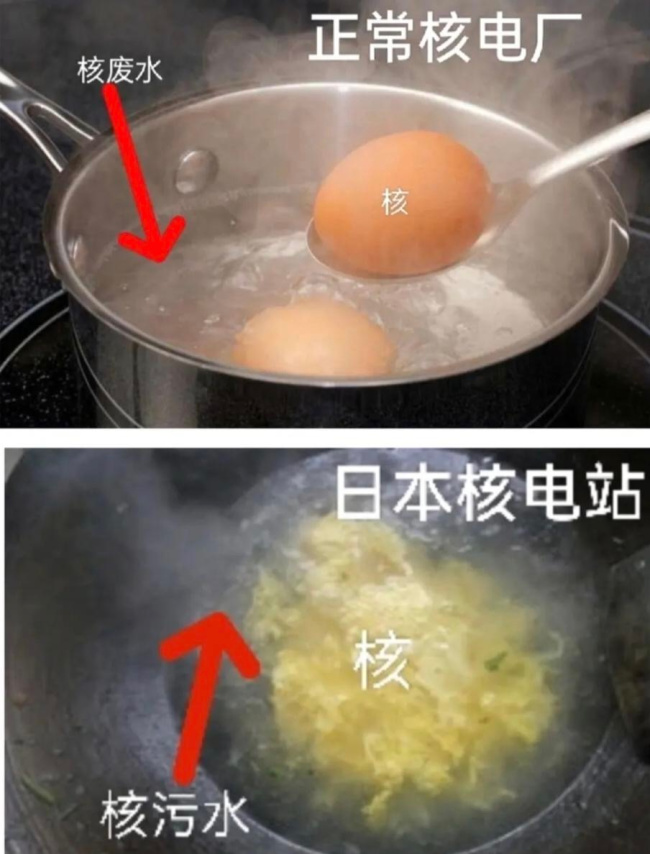
Meme showing “normal” nuclear wastewater compared to the Fukushima wastewater.
Over the past two days, at least five out of the top ten trending topics on Baidu’s hot news lists and the Weibo platform are linked to the discharge from the nuclear plant and its potential direct and indirect consequences.
We explain the top 5 biggest hashtags on Chinese social media and what’s behind them.
ANTI-JAPANESE SENTIMENTS
1: History Will Remember #历史会记住日本政府这一笔#
Among the top trending topics related to Japan’s release of Fukushima water is that “History will remember this move by the Japanese government” (#历史会记住日本政府这一笔#).
This phrase, turned into a hashtag, was initiated by Chinese state media outlet CCTV and also propagated by other official media, including China News Service.
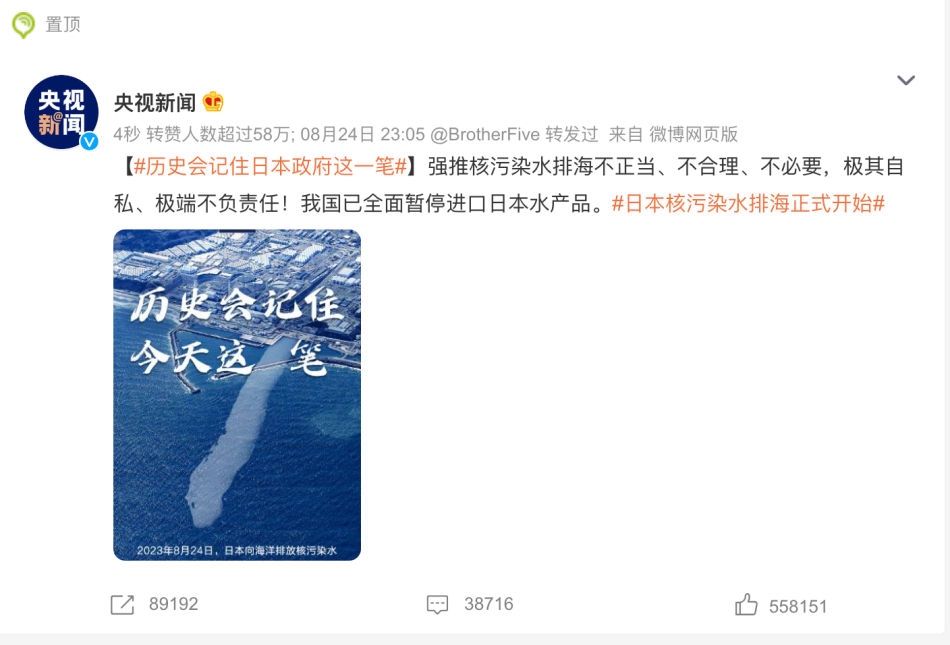
Post by CCTV, screenshot by What’s on Weibo.
“The people will remember, all the living creatures will remember,” one popular blogger’s post said, including various images of cute water animals. Other bloggers also followed with similar posts, writing things such as, “The sea otters will remember,” or “the entire world will remember what the Japanese government did this day [August 24].”
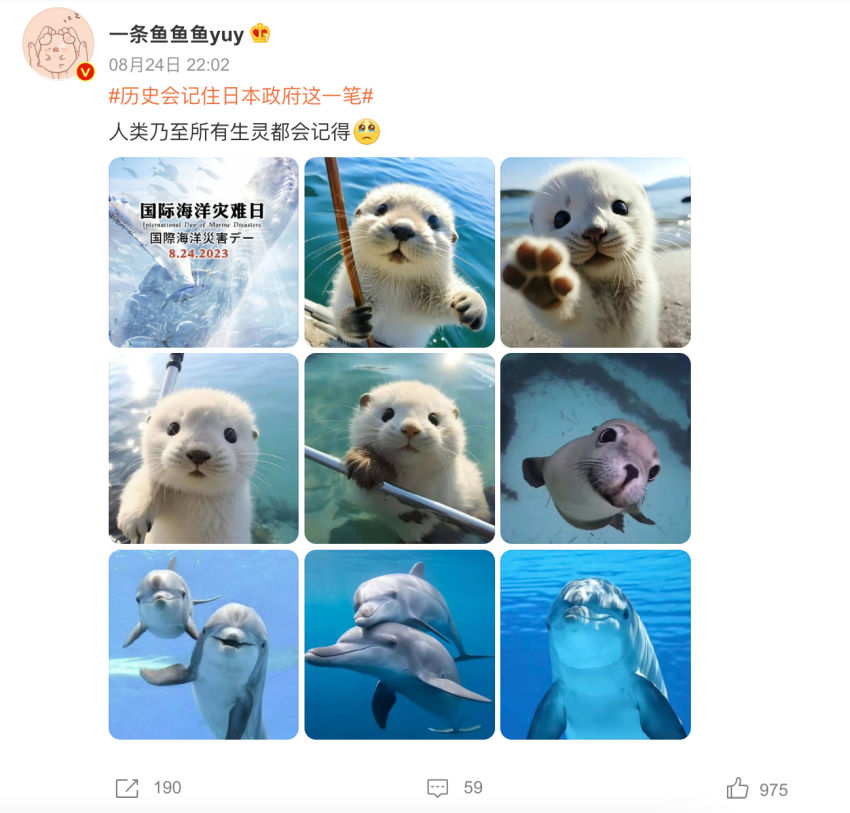
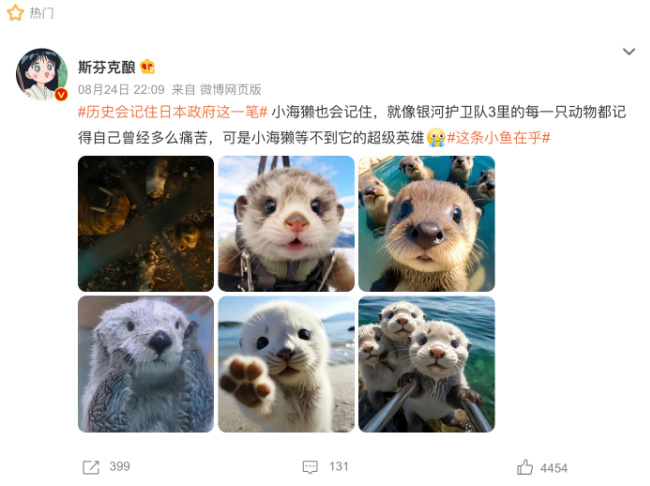
One post claimed that “the sea otters will also remember.”
While the expression pertains to the ecological consequences of the Fukushima water release, it also situates the incident within a broader historical framework where Japan assumes an aggressor role, with many online posts making direct or indirect references to the Second Sino-Japanese War (1937-1945) and WWII while voicing hate against Japan.
One Weibo user wrote: “History remembers, but the damned devils forget again. Do they remember the Anti-Japanese War? Are their brain cells telling them to destroy the earth?” Many other posts called Japan’s leadership “inhumane” and “evil.”
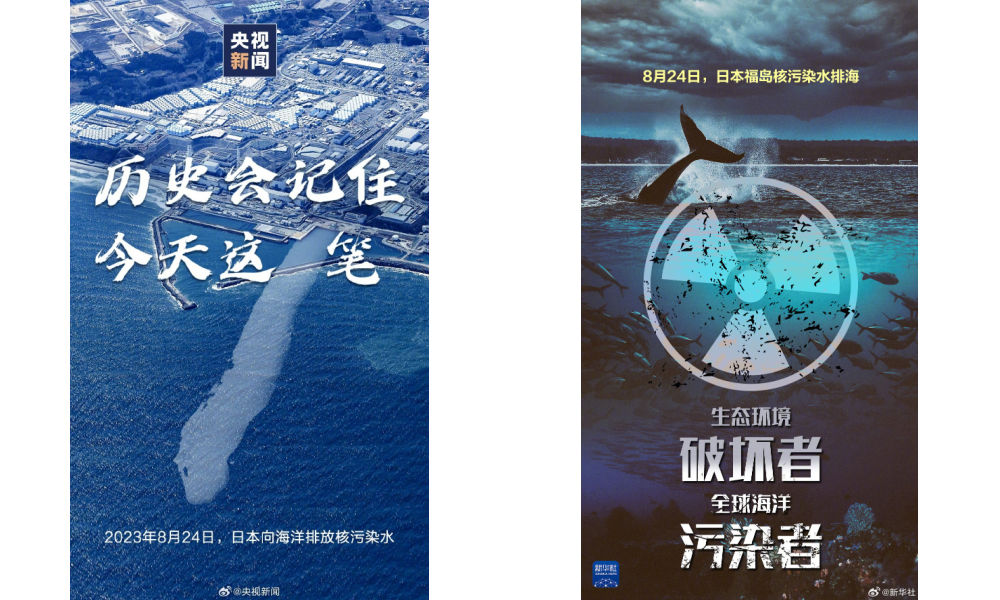
Online propaganda posters condeming Japan, by CCTV and Xinhua.
As is often done when there are major international clashes, Chinese state media outlets released online posters and slogans in relation to the event. In the Xinhua one, Japan was called a “destroyer” and “polluter.”
In an online media sphere where anti-Japanese voices are already ubiquitous in regular times, this ongoing event is another catalyst, igniting a resurgence of cybernationalism and intensified anti-Japanese rhetoric.
FOOD SAFETY & ANXIETY
2: China Suspends Import of Japanese Seafood #中方暂停进口日本水产品是完全必要的#
A second prominent subject of discussion is China’s decisive move to suspend the import of all Japanese aquatic products, which is deemed “absolutely necessary” (#中方暂停进口日本水产品是完全必要的#, 790 million views). Since the Fukushima disaster in 2011, China had already banned the import of almost all food products from prefectures near Fukushima.
China-based restaurants or online shops are also strictly prohibited from preparing and selling seafood products originating from Japan (#严禁采买日本水产品网络销售#, 85 million views).
While these news reports and related hashtags pages are initiated by state media outlets, like Global Times (环球网) and People’s Daily (人民日报), they also strike a chord with Chinese online users who harbor concerns about the potential direct repercussions of the Fukushima water release. The decision to entirely halt the import of Japanese aquatic products is decided by higher authorities, and reinforced by overwhelming public support.
This public support also arises from concerns about the implications of Japan’s decision for the well-being of Chinese citizens. These anxieties are intensified by reports in Chinese media, such as a recent one that highlighted “heavy rainfall in Osaka on the day of nuclear water discharge” (#日本核污染水排海当天大阪突降暴雨#, 230 million views). This report insinuated a direct link between the water discharge and the sudden rainstorm.
REPEATING PATTERNS
3: Panic Buying of Salt #中盐集团回应食盐抢购现象#
The commotion surrounding the news that Japan would start discharging the contaminated water into the ocean has led to people hoarding salt in supermarkets across the country. Online shops also ran out of salt.

Some online photos showed people leaving the supermarket with boxes filled with bags of salt.
The rush to hoard salt originates from worries about salt shortages, but it’s also driven by the belief that salt can act as an antidote for radiation poisoning. However, table salt is actually not advised to be used as a substitute for potassium iodide (KI) as it does not help with radiation poisoning, and eating large amounts could be harmful.
Panic buying before a lockdown? No, those days are over. It's hoarding salt in light of Japan's move to start discharging treated Fukushima water into the ocean, which has sparked consumer concerns over salt supplies combined with idea that salt can help protect against radiation pic.twitter.com/BLfgvGBRzT
— Manya Koetse (@manyapan) August 25, 2023
The surge in panic buying is tied to concerns about the repercussions of radioactive water in the sea. However, it also reflects a recurring pattern witnessed over the three years of dealing with Covid in China and pre-lockdown hoarding tendencies (see for example, or here), giving people a sense of control in a situation that is out of their control.
Meanwhile, salt industry associations and groups nationwide have appealed to the public not to engage in panic buying or hoarding of salt, stating that China has plenty of salt resources and that 90% of its salt production is not sea salt and remains completely unaffected by Japan’s nuclear pollution (#中盐集团回应食盐抢购现象#, 170 million views).
CONSUMER ACTIVISM
4: Consumer Boycott of Japanese Cosmetics #多家日妆品牌遭遇退货#
In the aftermath of the Japanese government’s formal announcement regarding the release of treated nuclear water into the sea, a substantial number of Chinese netizens have not only expressed their intent to abstain from consuming Japanese food, but have also committed to refraining from purchasing other Japanese products, including cosmetics.
Japanese cosmetic brands, including SK-II, Shiseido and Kose, are usually very popular among Chinese consumers. But since June 2023, when the tests began to discharge treated radioactive wastewater into the sea, consumers raised concerns about the safety of products originating from Japan.
According to Jing Daily, an online poll was conducted via social media app Xiaohongshu at the time. Out of 4,472 participants surveyed, approximately 79 percent conveyed their intention to discontinue the use of Japanese skincare and makeup products due to safety apprehensions.
This week, in a Weibo poll conducted by Sina News, more than 90 percent of respondents expressed their determination to stop buying Japanese cosmetics. Meanwhile, the hashtag “Several Japanese Cosmetic Brands See Items Returned” (#多家日妆品牌遭遇退货#, 120 million views), was among the top trending hashtags on Weibo.
This not only highlights their concerns about the safety of these products but also reflects a form of consumer nationalism, where boycotting Japanese goods becomes a manifestation of political activism.
The nationalistic intent behind this consumer behavior is emphasized by the state media outlet People’s Daily. They reported a news item about Chinese consumers purportedly returning Japanese cosmetics under the slogan: “We Endorse Made-in-China” (#我为国货代言#).
HIGHLIGHTING JAPANESE PROTEST AT HOME
5: The People Can’t Bear It #日本核污染水排海民众忍无可忍#
Other trending hashtags highlight how Japanese people themselves are also allegedly opposing their government’s decision to release Fukushima water.
One trending hashtag, “People Can’t Bear Japan Discharging Nuclear-Contaminated Water Into the Sea” (#日本核污染水排海民众忍无可忍#), has garnered over 710 million views on Weibo. It showcases how Fukushima residents expressed their concerns to Chinese reporters, criticizing the Japanese government and reiterating their opposition to the decision to release the radioactive water into the ocean.
Another popular hashtag is “Japan Scolded for Promoting Nuclear Contaminated Water to Students” (#日本向学生宣传核污水安全被骂#, 110 million views). Since 2021, the Japanese government allegedly distributed pamphlets at schools around the country to promote the “safety” and “lack of impact on health” of nuclear contaminated water.
Chinese media report how local educators have criticized these pamphlets for “deceiving innocent children.”
While there is an online inclination to distinguish between the Japanese government and the Japanese people, there are also online trends that criticize Japanese residents. For instance, there’s a story circulating about Japanese individuals swimming in the sea on August 25 (#核污水排海后日本人在海里游泳#). Some comments read, “You see, they just don’t care,” while many others exhibit clear anti-Japanese sentiments, saying, “Let them swim in it and drink their contaminated water.”
In light of the waves of anti-Japanese sentiments that China’s online media environment has seen over the past few days, the Japanese embassy in Beijing issued a warning to Japanese citizens in China on its website on August 25. They advise Japanese citizens to be careful when going out, and to refrain from “unnecessarily speaking Japanese loudly” (#日本大使馆提醒在华日本民众不要大声说日语#).
Meanwhile, at the time of writing, another Japan-related hashtag has surged to the number one spot on Weibo’s top trending lists, namely “Two Earthquakes In One Day” (#日本一天内两次地震#, 210 million views), about Japan experiencing two offshore earthquakes. “It’s karma,” many commenters write, with others also echoing a popular view: “It’s not a coincidence. The heavens are watching.”
By Manya Koetse
With contributions by Miranda Barnes
Get the story behind the hashtag. Subscribe to What’s on Weibo here to receive our newsletter and get access to our latest articles:
Spotted a mistake or want to add something? Please let us know in comments below or email us. First-time commenters, please be patient – we will have to manually approve your comment before it appears.
©2023 Whatsonweibo. All rights reserved. Do not reproduce our content without permission – you can contact us at info@whatsonweibo.com.

Post by CCTV, screenshot by What’s on Weibo.


One post claimed that “the sea otters will also remember.”

Online propaganda posters condeming Japan, by CCTV and Xinhua.
FOOD SAFETY & ANXIETY
A second prominent subject of discussion is China’s decisive move to suspend the import of all Japanese aquatic products, which is deemed “absolutely necessary” (#中方暂停进口日本水产品是完全必要的#, 790 million views). Since the Fukushima disaster in 2011, China had already banned the import of almost all food products from prefectures near Fukushima.
China-based restaurants or online shops are also strictly prohibited from preparing and selling seafood products originating from Japan (#严禁采买日本水产品网络销售#, 85 million views).
While these news reports and related hashtags pages are initiated by state media outlets, like Global Times (环球网) and People’s Daily (人民日报), they also strike a chord with Chinese online users who harbor concerns about the potential direct repercussions of the Fukushima water release. The decision to entirely halt the import of Japanese aquatic products is decided by higher authorities, and reinforced by overwhelming public support.
This public support also arises from concerns about the implications of Japan’s decision for the well-being of Chinese citizens. These anxieties are intensified by reports in Chinese media, such as a recent one that highlighted “heavy rainfall in Osaka on the day of nuclear water discharge” (#日本核污染水排海当天大阪突降暴雨#, 230 million views). This report insinuated a direct link between the water discharge and the sudden rainstorm.
REPEATING PATTERNS
3: Panic Buying of Salt #中盐集团回应食盐抢购现象#
The commotion surrounding the news that Japan would start discharging the contaminated water into the ocean has led to people hoarding salt in supermarkets across the country. Online shops also ran out of salt.

Some online photos showed people leaving the supermarket with boxes filled with bags of salt.
The rush to hoard salt originates from worries about salt shortages, but it’s also driven by the belief that salt can act as an antidote for radiation poisoning. However, table salt is actually not advised to be used as a substitute for potassium iodide (KI) as it does not help with radiation poisoning, and eating large amounts could be harmful.
Panic buying before a lockdown? No, those days are over. It's hoarding salt in light of Japan's move to start discharging treated Fukushima water into the ocean, which has sparked consumer concerns over salt supplies combined with idea that salt can help protect against radiation pic.twitter.com/BLfgvGBRzT
— Manya Koetse (@manyapan) August 25, 2023
The surge in panic buying is tied to concerns about the repercussions of radioactive water in the sea. However, it also reflects a recurring pattern witnessed over the three years of dealing with Covid in China and pre-lockdown hoarding tendencies (see for example, or here), giving people a sense of control in a situation that is out of their control.
Meanwhile, salt industry associations and groups nationwide have appealed to the public not to engage in panic buying or hoarding of salt, stating that China has plenty of salt resources and that 90% of its salt production is not sea salt and remains completely unaffected by Japan’s nuclear pollution (#中盐集团回应食盐抢购现象#, 170 million views).
CONSUMER ACTIVISM
4: Consumer Boycott of Japanese Cosmetics #多家日妆品牌遭遇退货#
In the aftermath of the Japanese government’s formal announcement regarding the release of treated nuclear water into the sea, a substantial number of Chinese netizens have not only expressed their intent to abstain from consuming Japanese food, but have also committed to refraining from purchasing other Japanese products, including cosmetics.
Japanese cosmetic brands, including SK-II, Shiseido and Kose, are usually very popular among Chinese consumers. But since June 2023, when the tests began to discharge treated radioactive wastewater into the sea, consumers raised concerns about the safety of products originating from Japan.
According to Jing Daily, an online poll was conducted via social media app Xiaohongshu at the time. Out of 4,472 participants surveyed, approximately 79 percent conveyed their intention to discontinue the use of Japanese skincare and makeup products due to safety apprehensions.
This week, in a Weibo poll conducted by Sina News, more than 90 percent of respondents expressed their determination to stop buying Japanese cosmetics. Meanwhile, the hashtag “Several Japanese Cosmetic Brands See Items Returned” (#多家日妆品牌遭遇退货#, 120 million views), was among the top trending hashtags on Weibo.
This not only highlights their concerns about the safety of these products but also reflects a form of consumer nationalism, where boycotting Japanese goods becomes a manifestation of political activism.
The nationalistic intent behind this consumer behavior is emphasized by the state media outlet People’s Daily. They reported a news item about Chinese consumers purportedly returning Japanese cosmetics under the slogan: “We Endorse Made-in-China” (#我为国货代言#).
HIGHLIGHTING JAPANESE PROTEST AT HOME
5: The People Can’t Bear It #日本核污染水排海民众忍无可忍#
Other trending hashtags highlight how Japanese people themselves are also allegedly opposing their government’s decision to release Fukushima water.
One trending hashtag, “People Can’t Bear Japan Discharging Nuclear-Contaminated Water Into the Sea” (#日本核污染水排海民众忍无可忍#), has garnered over 710 million views on Weibo. It showcases how Fukushima residents expressed their concerns to Chinese reporters, criticizing the Japanese government and reiterating their opposition to the decision to release the radioactive water into the ocean.
Another popular hashtag is “Japan Scolded for Promoting Nuclear Contaminated Water to Students” (#日本向学生宣传核污水安全被骂#, 110 million views). Since 2021, the Japanese government allegedly distributed pamphlets at schools around the country to promote the “safety” and “lack of impact on health” of nuclear contaminated water.
Chinese media report how local educators have criticized these pamphlets for “deceiving innocent children.”
While there is an online inclination to distinguish between the Japanese government and the Japanese people, there are also online trends that criticize Japanese residents. For instance, there’s a story circulating about Japanese individuals swimming in the sea on August 25 (#核污水排海后日本人在海里游泳#). Some comments read, “You see, they just don’t care,” while many others exhibit clear anti-Japanese sentiments, saying, “Let them swim in it and drink their contaminated water.”
In light of the waves of anti-Japanese sentiments that China’s online media environment has seen over the past few days, the Japanese embassy in Beijing issued a warning to Japanese citizens in China on its website on August 25. They advise Japanese citizens to be careful when going out, and to refrain from “unnecessarily speaking Japanese loudly” (#日本大使馆提醒在华日本民众不要大声说日语#).
Meanwhile, at the time of writing, another Japan-related hashtag has surged to the number one spot on Weibo’s top trending lists, namely “Two Earthquakes In One Day” (#日本一天内两次地震#, 210 million views), about Japan experiencing two offshore earthquakes. “It’s karma,” many commenters write, with others also echoing a popular view: “It’s not a coincidence. The heavens are watching.”
By Manya Koetse
With contributions by Miranda Barnes
Get the story behind the hashtag. Subscribe to What’s on Weibo here to receive our newsletter and get access to our latest articles:
Spotted a mistake or want to add something? Please let us know in comments below or email us. First-time commenters, please be patient – we will have to manually approve your comment before it appears.
©2023 Whatsonweibo. All rights reserved. Do not reproduce our content without permission – you can contact us at info@whatsonweibo.com.

Some online photos showed people leaving the supermarket with boxes filled with bags of salt.
Panic buying before a lockdown? No, those days are over. It's hoarding salt in light of Japan's move to start discharging treated Fukushima water into the ocean, which has sparked consumer concerns over salt supplies combined with idea that salt can help protect against radiation pic.twitter.com/BLfgvGBRzT
— Manya Koetse (@manyapan) August 25, 2023
CONSUMER ACTIVISM
In the aftermath of the Japanese government’s formal announcement regarding the release of treated nuclear water into the sea, a substantial number of Chinese netizens have not only expressed their intent to abstain from consuming Japanese food, but have also committed to refraining from purchasing other Japanese products, including cosmetics.
Japanese cosmetic brands, including SK-II, Shiseido and Kose, are usually very popular among Chinese consumers. But since June 2023, when the tests began to discharge treated radioactive wastewater into the sea, consumers raised concerns about the safety of products originating from Japan.
According to Jing Daily, an online poll was conducted via social media app Xiaohongshu at the time. Out of 4,472 participants surveyed, approximately 79 percent conveyed their intention to discontinue the use of Japanese skincare and makeup products due to safety apprehensions.
This week, in a Weibo poll conducted by Sina News, more than 90 percent of respondents expressed their determination to stop buying Japanese cosmetics. Meanwhile, the hashtag “Several Japanese Cosmetic Brands See Items Returned” (#多家日妆品牌遭遇退货#, 120 million views), was among the top trending hashtags on Weibo.
This not only highlights their concerns about the safety of these products but also reflects a form of consumer nationalism, where boycotting Japanese goods becomes a manifestation of political activism.
The nationalistic intent behind this consumer behavior is emphasized by the state media outlet People’s Daily. They reported a news item about Chinese consumers purportedly returning Japanese cosmetics under the slogan: “We Endorse Made-in-China” (#我为国货代言#).
HIGHLIGHTING JAPANESE PROTEST AT HOME
5: The People Can’t Bear It #日本核污染水排海民众忍无可忍#
Other trending hashtags highlight how Japanese people themselves are also allegedly opposing their government’s decision to release Fukushima water.
One trending hashtag, “People Can’t Bear Japan Discharging Nuclear-Contaminated Water Into the Sea” (#日本核污染水排海民众忍无可忍#), has garnered over 710 million views on Weibo. It showcases how Fukushima residents expressed their concerns to Chinese reporters, criticizing the Japanese government and reiterating their opposition to the decision to release the radioactive water into the ocean.
Another popular hashtag is “Japan Scolded for Promoting Nuclear Contaminated Water to Students” (#日本向学生宣传核污水安全被骂#, 110 million views). Since 2021, the Japanese government allegedly distributed pamphlets at schools around the country to promote the “safety” and “lack of impact on health” of nuclear contaminated water.
Chinese media report how local educators have criticized these pamphlets for “deceiving innocent children.”
While there is an online inclination to distinguish between the Japanese government and the Japanese people, there are also online trends that criticize Japanese residents. For instance, there’s a story circulating about Japanese individuals swimming in the sea on August 25 (#核污水排海后日本人在海里游泳#). Some comments read, “You see, they just don’t care,” while many others exhibit clear anti-Japanese sentiments, saying, “Let them swim in it and drink their contaminated water.”
In light of the waves of anti-Japanese sentiments that China’s online media environment has seen over the past few days, the Japanese embassy in Beijing issued a warning to Japanese citizens in China on its website on August 25. They advise Japanese citizens to be careful when going out, and to refrain from “unnecessarily speaking Japanese loudly” (#日本大使馆提醒在华日本民众不要大声说日语#).
Meanwhile, at the time of writing, another Japan-related hashtag has surged to the number one spot on Weibo’s top trending lists, namely “Two Earthquakes In One Day” (#日本一天内两次地震#, 210 million views), about Japan experiencing two offshore earthquakes. “It’s karma,” many commenters write, with others also echoing a popular view: “It’s not a coincidence. The heavens are watching.”
By Manya Koetse
With contributions by Miranda Barnes
Get the story behind the hashtag. Subscribe to What’s on Weibo here to receive our newsletter and get access to our latest articles:
Spotted a mistake or want to add something? Please let us know in comments below or email us. First-time commenters, please be patient – we will have to manually approve your comment before it appears.
©2023 Whatsonweibo. All rights reserved. Do not reproduce our content without permission – you can contact us at info@whatsonweibo.com.
Manya is the founder and editor-in-chief of What's on Weibo, offering independent analysis of social trends, online media, and digital culture in China for over a decade. Subscribe to gain access to content, including the Weibo Watch newsletter, which provides deeper insights into the China trends that matter. More about Manya at manyakoetse.com or follow on X.
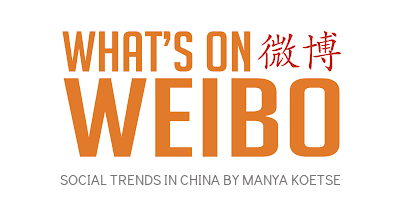
China Media
China’s “AFP Filter” Meme: How Netizens Turned a Western Media Lens into Online Patriotism
Chinese netizens embraced a supposed “demonizing” Western gaze in AFP photos and made it their own.
Published
4 weeks agoon
September 10, 2025By
Ruixin Zhang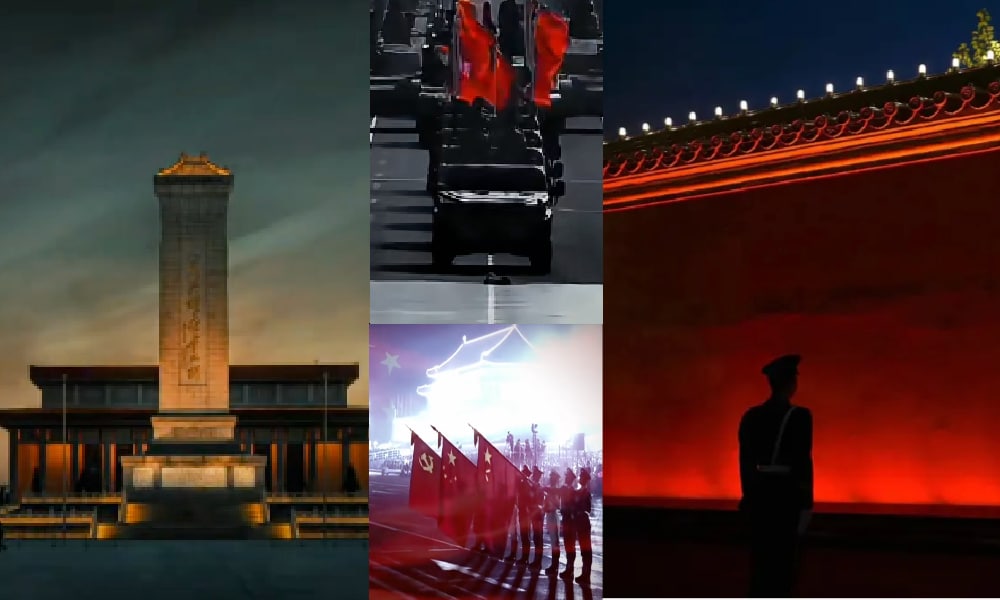
For a long time, Chinese netizens have criticized how photography of Chinese news events by Western outlets—from BBC and CNN to AFP—makes China look more gloomy or intimidating. During this year’s military parade, the so-called “AFP filter” once again became a hot topic—and perhaps not in the way you’d expect.
In the past week following the military parade, Chinese social media remained filled with discussions about the much-anticipated September 3 V-Day parade, a spectacle that had been hyped for weeks and watched by millions across the country.
That morning, Chinese leader Xi Jinping, accompanied by his wife Peng Liyuan, welcomed international guests on the red carpet. When Xi arrived at Tiananmen Square alongside Russian President Vladimir Putin and North Korean leader Kim Jong-un, office phone calls across the country quieted, and school classes paused to tune in to one of China’s largest-ever military parades along Chang’an Avenue in Beijing, held to commemorate China’s victory over Japan in the Second Sino-Japanese War and World War II.
As tanks rolled and jets thundered overhead, and state media outlets such as People’s Daily and Xinhua livestreamed the entire event, many different details—from what happened on Tiananmen Square to who attended, and what happened before and after, both online and offline—captured the attention of netizens.
Amid all the discussions online, one particularly hot conversation was about the visual coverage of the event, and focused on AFP (法新社), Agence France Press, the global news agency headquartered in Paris.
Typing “AFP” (法新社) into Weibo in the days after the parade pulled up a long list of hashtags:
- Has AFP released their shots yet?
- V-Day Parade through AFP’s lens
- AFP’s god-tier photo
- Did AFP show up for the parade?
The fixation may seem odd—why would Chinese netizens care so much about a French news agency?

Popular queries centered on AFP.
The story actually goes back to 2022.
In July of that year, on the anniversary of the Communist Party’s founding, one Weibo influencer (@Jokielicious) noted that while domestic photographers portrayed the celebrations as bright and triumphant, she personally preferred the darker, almost menacing image of Beijing captured by Western journalists. In her view, through their lens, China appeared more powerful—even a little terrifying.
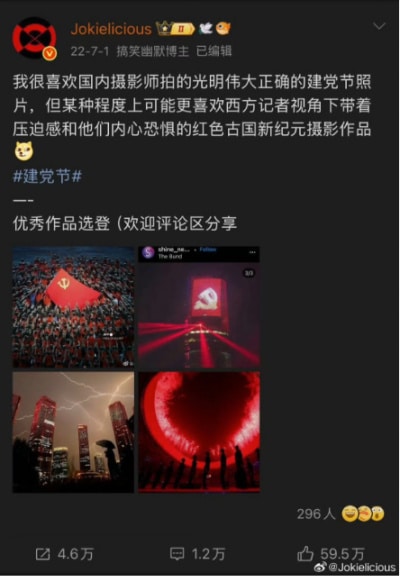
The original post.
The post went viral. Soon, netizens began comparing more of China’s state media photos with those from Western outlets. One photo in particular stood out: Xinhua’s casual, cheerful shot of Chinese soldiers contrasted sharply with AFP’s cold, almost cinematic frame.
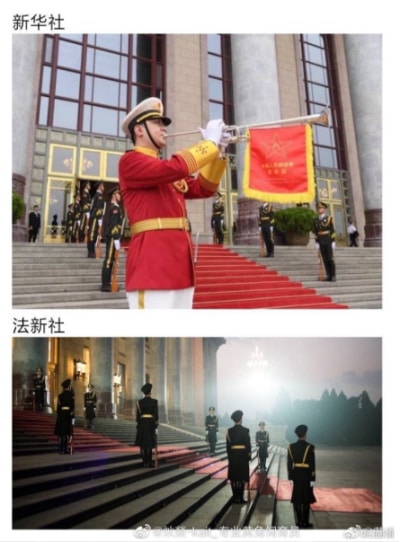
Same event, different vibe. Chinese social media users compared these photos of Xinhua (top) versus AFP (down). AFP photo shot by Fred Dufour.
Netizens joked that Xinhua had made the celebration look like the opening of a new hotel, while AFP had cast it as “the dawn of an empire.”
Gradually, what began as a dig at the bad aesthetics of state media turned into something else: a subtle shift in how Chinese netizens were rethinking their country’s international image.
Under the hashtag #ChinaThroughOthersLens (#老中他拍), netizens shared images of China as seen through the lenses of various Western media outlets.
This wasn’t the first time such talk had appeared. In the early days of the Chinese internet, people often spoke of the so-called “BBC filter.” The idea was that the BBC habitually put footage of China under a grayish filter, making its visuals give off a vibe of repression and doom, which many felt was at odds with the actual vibrancy on the ground. To them, it was proof that the West was bent on painting China as backward and gloomy.
These discussions have continued in recent years.
For example, on Weibo there were debates about a photo of the Wuhan Institute of Virology, shot by Peter Thomas for Reuters, and used in various Western media reports about Wuhan and Covid as early as 2021. The top image shows the photographer’s vantage point.
“Looks like a cockroach in the gutter,” one popular comment described it.

Top image by Chinese media, lower image by Peter Thomas/Reuters, and was used in various Western media reports about Wuhan and Covid since as early as 2021.
Another example is the alleged “smog filter” applied by Western media outlets to Beijing skies during the China visit of US Secretary of State Antony Blinken in 2024.
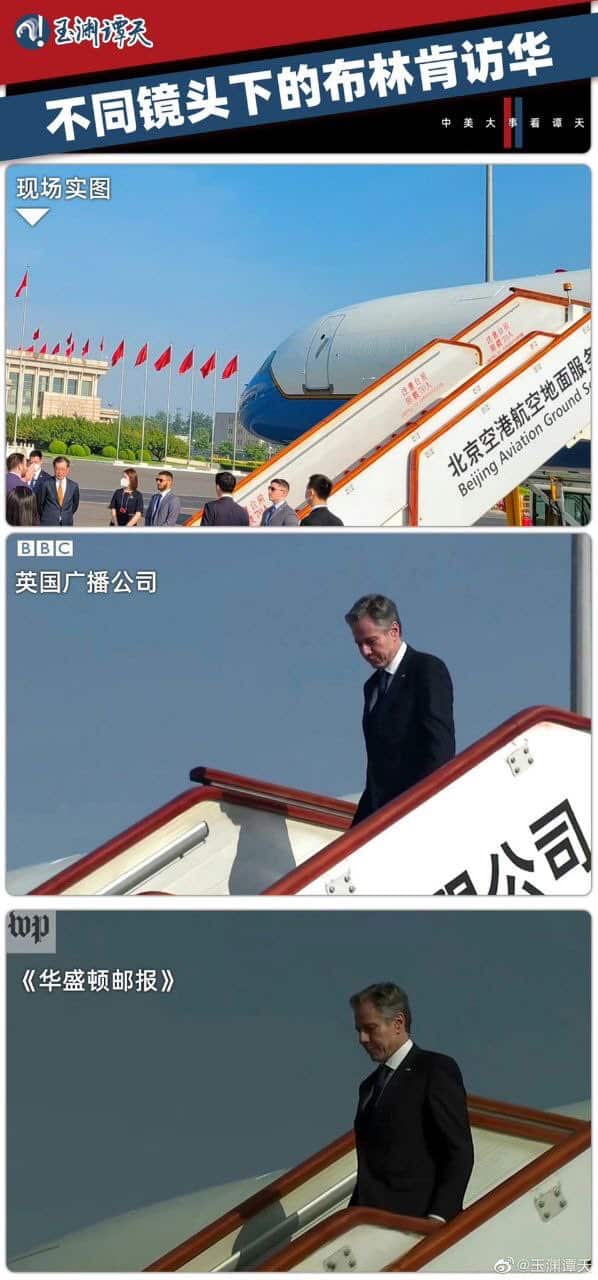
The alleged “smog filter” applied to Beijing skies during Blinken’s visit. Top image: Chinese media. Middle: BBC. Lower: Washington Post.
AFP, meanwhile, seemed to offer a different kind of ‘distortion.’
Netizens said AFP’s photos often had a low-saturation, high-contrast, solemn tone, with wide angles that made the scenes feel oppressive yet majestic. Over time, any photo with that look—whether taken by AFP or not—was dubbed the “AFP filter” (法新社滤镜).
AFP has clarified multiple times that many of the viral examples weren’t even theirs—or that they were, but had been altered with an extra dark filter. They also refuted claims that AFP had published a photo series of Chinese soldiers titled “Dawn of Empire” to discredit China’s army.
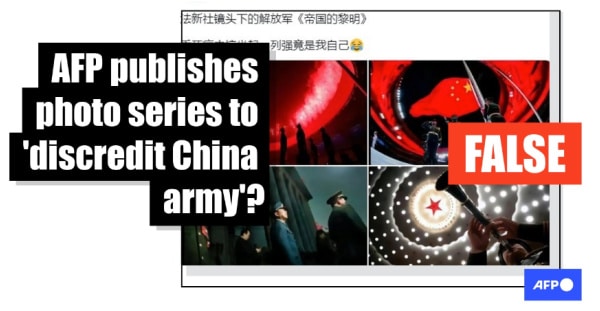
AFP refuted claims that their photos discredited the Chinese army.
Nevertheless, the “AFP filter” label stuck. It became shorthand for a Western gaze that cast China not as impoverished or broken—as some claimed the “BBC filter” did—but as formidable, like a looming supervillain.
One running joke summed it up neatly: domestic shots are the festive version; Western shots are the red-tyrant version. And increasingly, netizens admitted they preferred the latter, commenting that while AFP shots often emphasize red to suggest authoritarianism, they actually like the red and what it stands for.
So, when this year’s V-Day came around, many were eager to see how AFP and other Western outlets would frame China as the dark, dangerous empire.
But when the photos dropped, the reaction was muted. They looked average. Some called them “disappointing.” “Where are the dark angles? Not doing it this time?” one blogger wondered. “Where’s the AFP hotline? I’d like to file a complaint!”
“Xinhua actually beat you this time,” some commented on AFP’s official Weibo account. Others agreed, putting the AFP photos and Xinhua photos side by side.
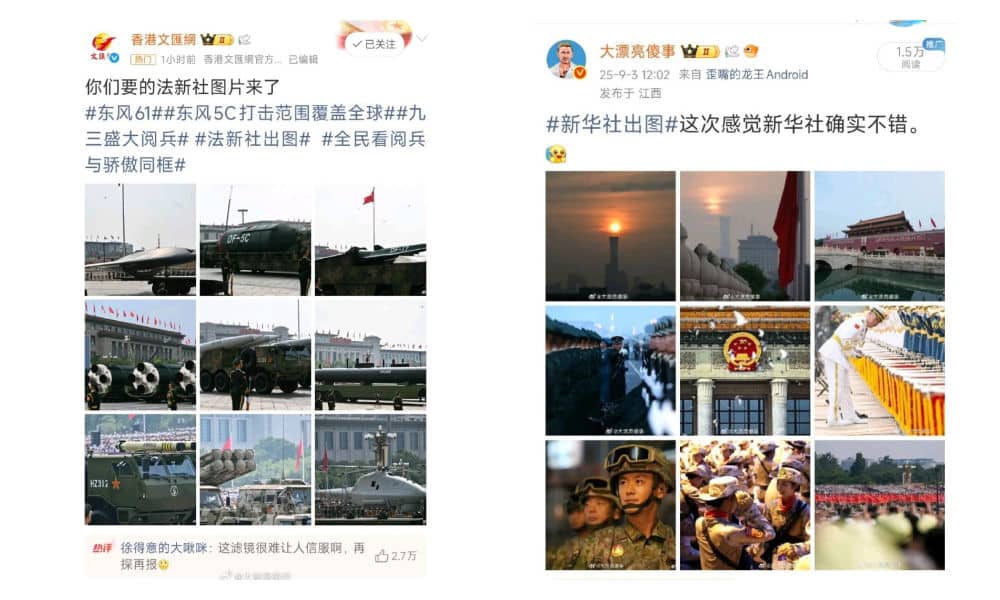
AFP photos on the left versus Xinhua photos on the right.
To make up for the letdown, people began editing the photos themselves—darkening the tones, adding dramatic shadows, and proudly labeling them with the tag “AFP filter” or calling it “The September 3rd Military Parade Through a AFP Lens” (法新社滤镜下的9.3阅兵). “Now that’s the right vibe,” they said: “I fixed it for you!”
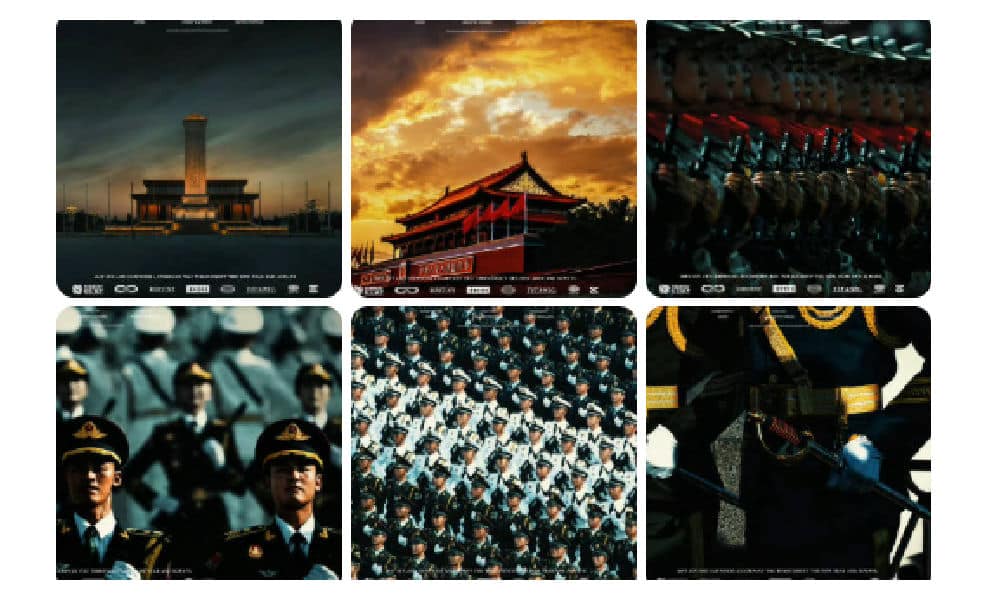
Netizen @哔哔机 “AFP-fied” photos of the military parade by AFP.
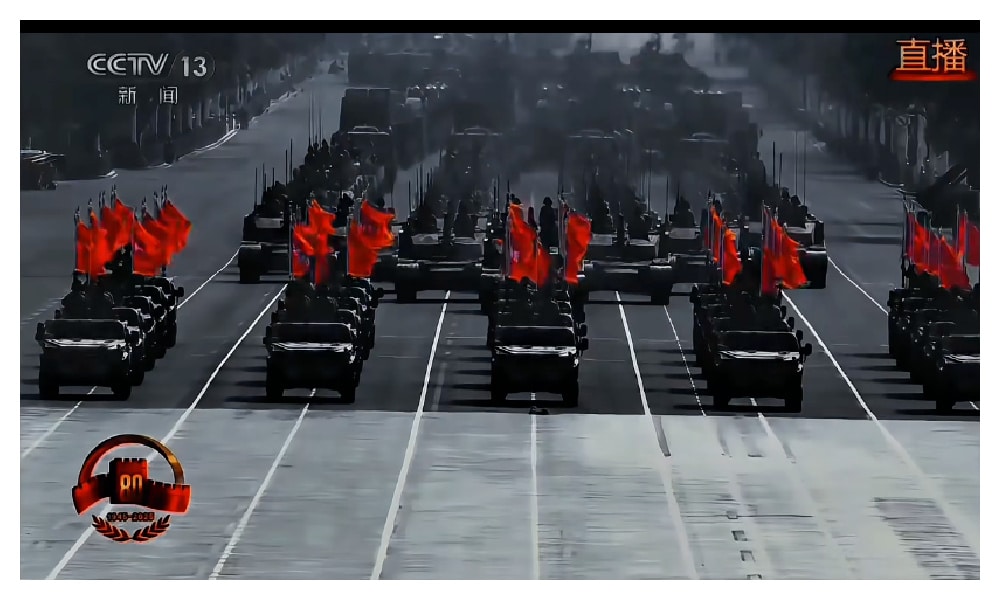
Official media quickly picked up on the trend. Xinhua rolled out its own hashtags—#XinhuaAlwaysDeliversEpicShots (#新华社必出神图的决心#) and #XinhuaWins (#新华社秒了#)—and positioned itself as the true master of a new aesthetic narrative.
The message was clear: China no longer needs the Western gaze to frame itself as powerful or intimidating; it can do that on its own.
The “AFP v Xinhua” contest, the online movement to “AFP-ify” visuals, and the Chinese fandom around AFP’s moodier shots may have been wrapped in jokes and memes, but they also pointed to something deeper: the once “demonized” image of China that Western media pushed as threatening is now not only accepted by Chinese netizens, it’s embraced. Many have made it part of a confident, playful form of online patriotism, applauding the idea of being seen by the West as fearsome, even villainous, believing it amplifies China’s global authority.
As one netizen wrote: “I like it when we look like we crawl straight into their nightmares.”
Chinese journalist Kai Lei (@凯雷) suggested that these kinds of trends showed how the Chinese public plays an increasingly proactive role in shaping China’s global image.
By now, the AFP meme has become so strong that it doesn’t even require AFP anymore. Ultra-dramatic shots are simply called “AFP-level photos” (法新社级别).
For now, as many are enjoying the “afterglow” of the military parade, their appreciation for the AFP-style only seems to grow. As one Weibo user summed it up: “AFP tried to create a sense of oppression with dark, low-angle shots, but instead only strengthened the Chinese military’s aura of majesty.”
– By Ruixin Zhang and Manya Koetse
Spotted a mistake or want to add something? Please let us know in comments below or email us. First-time commenters, please be patient – we will have to manually approve your comment before it appears.
©2025 Whatsonweibo. All rights reserved. Do not reproduce our content without permission – you can contact us at info@whatsonweibo.com.
China Arts & Entertainment
Yearnings, Dreamcore, and the Rise of AI Nostalgia in China
From China’s first soap opera Yearnings to the rise of AI-fueled nostalgia.
Published
3 months agoon
July 2, 2025
The year is 1990, and the streets of Beijing’s Fangshan District are eerily quiet. You can almost hear a pin drop in the petrochemical town, as tens of thousands of workers and their families huddle around their televisions, all tuned to the same channel for something groundbreaking: China’s very first soap opera, Yearnings (渴望 Kěwàng).
Yearnings tells the story of Liu Huifang (刘慧芳), a female factory worker from a traditional working-class family in Beijing, and her unlikely marriage to university graduate Wang Husheng (王沪生), who comes from a family of intellectuals. When Liu finds an abandoned baby girl, she adopts her and raises her as her own, against her husband’s wishes.
The couple is unaware that the foundling is actually the illegitimate child of Wang’s snobbish sister, Yaru. After Liu and Wang have a biological son, the marriage comes under further pressure, eventually leading to divorce. Liu is left as a single mother, raising two children on her own.
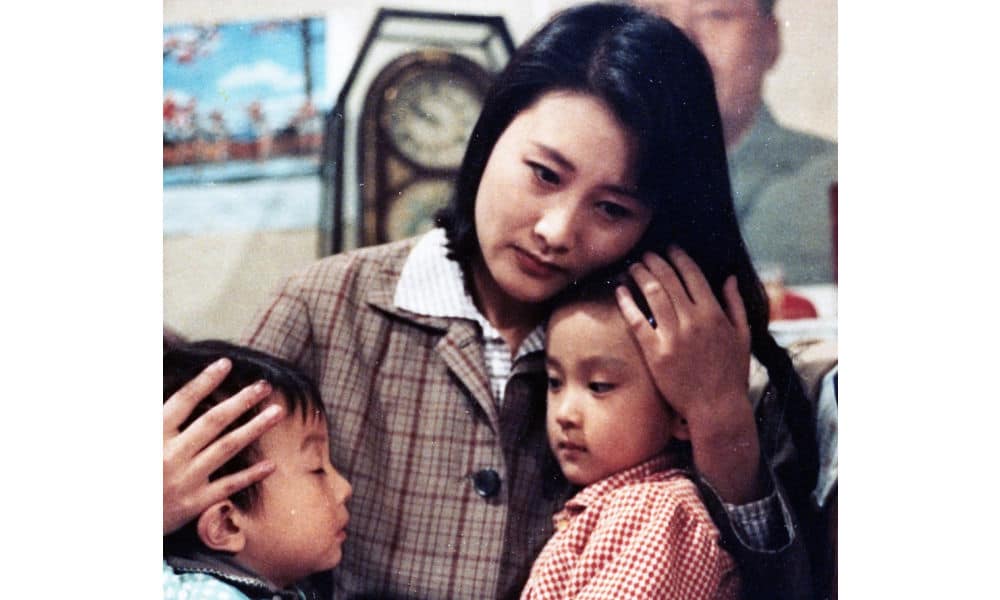
Still from Yearnings, via OurChinaStory.
Drawing inspiration from foreign dubbed television shows, Yearnings was produced as China’s first truly domestic, long-form indoor television drama. Spanning 50 episodes, the series traces a timeline from the onset of the Cultural Revolution in the 1960s through to the late 1980s—one of the most turbulent periods in modern Chinese history.
Before the series aired nationally on CCTV and achieved record viewership, the first station to air Yearnings in the Beijing region was the Yanshan Petrochemical TV Station (燕山石化电视台), China’s first major factory TV station (厂办电视台) located in Fangshan District.
Here, in this town of over 100,000, Yearnings garnered an astonishing and unprecedented 98% audience share. The series was truly groundbreaking and became a national sensation—not just because it was China’s first long-form television drama, or because it was a locally produced drama that challenged the long-standing monopoly of state broadcaster CCTV, but because Yearnings marked a major shift in television storytelling.
Until then, Chinese TV stories had always revolved around communist propaganda, or featured great heroes of the revolution. Yearnings, on the other hand, was devoid of political content and focused on the hopes and dreams of ordinary people and their everyday struggles—love, desire, marital tension, single motherhood—topics that had never before been so openly portrayed on Chinese television.
The show’s creators had perfectly tapped into what was changing: the Communist Party was slowly withdrawing from private life, and people were beginning to see themselves less defined by their work unit and more by their home life—as consumers, as partners and parents, as citizens of a new China filled with aspirations for the future. Yearnings’ storyline was a reflection of that.
Chinese-Style “Nostalgia Core”
Yearnings marked a cultural turning point, coinciding with the rapid spread of TV sets in Chinese households. In 1992, economic reforms triggered a new era in which Chinese media became increasingly commercialized and thriving, before the arrival of the internet, social media, and AI tools once again changed everything.
Today, Yearnings still is a topic that often comes up in Chinese online media. On apps like Douyin, old scenes from Yearnings are reposted and receive thousands of shares.
📌 It’s emblematic of a broader trend in which more netizens are turning to “nostalgia-core.” In Chinese, this trend is known as “中式梦核” (Zhōngshì Mènghé), which literally means “Chinese-style dreamcore.”
Dreamcore is an internet aesthetic and visual style—popular in online communities like Tumblr and Reddit—that blends elements of nostalgia, surrealism, and subconscious imagery. Mixing retro images with fantasy, it evokes a sense of familiarity, yet often feels unsettling and deserted.
The Chinese-style dreamcore (中式梦核), which has become increasingly popular on platforms like Bilibili since 2023-2024, is different from its Western counterpart in how it incorporates distinctly Chinese elements and specifically evokes the childhood experiences of the millennial generation. Content tagged as “Chinese-style dreamcore” on Chinese social media is often also labeled with terms like “nostalgia” (怀旧), “childhood memories” (童年回忆), “when we were little” (小时候), and “Millennial Dream” (千禧梦).
According to the blogging account Yatong Local Life Observer (娅桐本地生活观察), the focus on the millennial childhood can be explained because the formative years of this generation coincided with a decade of rapid social change in China —leaving little in today’s modern cities that still evokes that era.
🌀 Of course, millennials in the West also frequently look back at their childhood and teenage years, particularly the 1980s and 1990s—a trend also embraced by Gen Z, who romanticize these years through media and fashion. In China, however, Gen Z is at the forefront of the “nostalgia-core” trend, reflecting on the 1990s and early 2000s as a distant, almost dreamlike past. This sense of distance is heightened by China’s staggering pace of transformation, modernization, and digitalization over the past decades, which has made even the recent past feel remote and irretrievable.
🌀 Another factor contributing to the trend is that China’s younger generations are caught in a rat race of academic and professional competition, often feeling overwhelmed by the fast pace of life and the weight of societal expectations. In this high-pressure environment—captured by the concept of “involution” (内卷)—young people develop various coping mechanisms, and digital escapism, including nostalgia-core, is one of them. It’s like a cyber-utopia (赛博乌托邦).
🌀 Due to the rise of AI tools available to the general public, Chinese-style nostalgia core has hit the mainstream because it’s now possible for all social media users to create their own nostalgic videos and images—bringing back the 1990s and early 2000s through AI-generated tools, either by making real videos appear more nostalgic or by creating entirely fictional videos or images that recreate scenes from those days.
So what are we seeing? There are images and videos of stickers kids used to love, visuals showing old classrooms, furniture, and children playing outside, accompanied by captions such as “we’re already so far apart from our childhood years” (example).
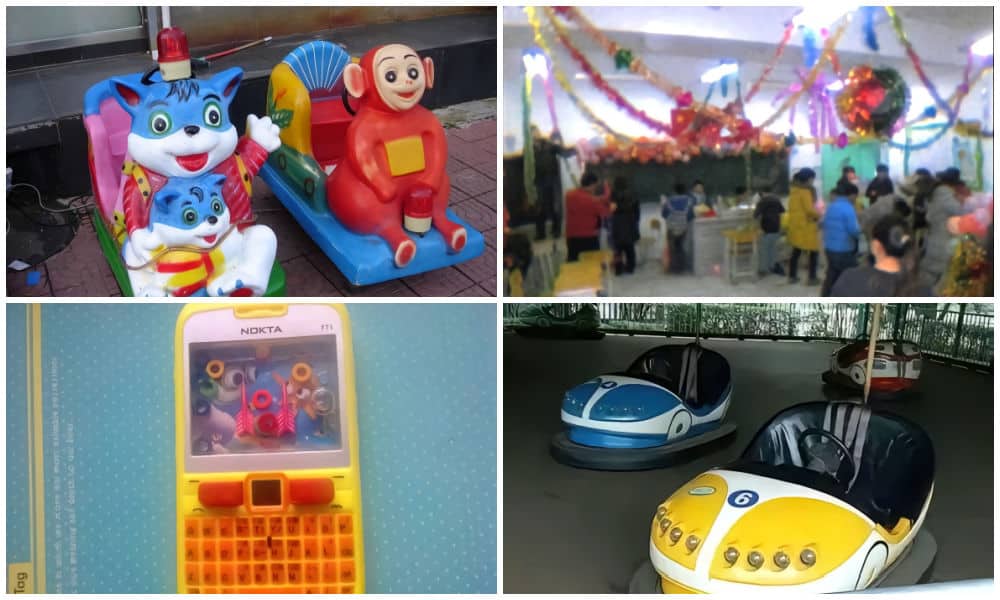
Images displayed in Chinese Dreamcore.
And notably, there are videos and images showing family and friends gathering around those old big TVs as a cultural, ritualized activity (see some examples here).

Stills from ‘nostalgia core’ videos.
These kinds of AI-generated videos depict a pre-mobile-era family life, where families and communities would gather around the TV—both inside and outside—from classrooms to family homes. The wind blows through the windows, neighbors crack sunflower seeds, and children play on the ground. Ironically, it’s AI that is bringing back the memories of a society that was not yet digitalized.
Nowadays, with dozens of short video apps, streaming platforms, and livestream culture fully mainstream in China—and AI algorithms personalizing feeds to the extreme—it sometimes feels like everyone’s on a different channel, quite literally.
In times like these, people long for an era when life seemed less complicated—when, instead of everyone staring at their own screens, families and neighbors gathered around one screen together.
There’s not just irony in the fact that it took AI for netizens to visualize their longing for a bygone era; there’s also a deeper irony in how Yearnings once represented a time when people were looking forward to the future—only to find that the future is now looking back, yearning for the days of Yearnings.
It seems we’re always looking back, reminiscing about the years behind us with a touch of nostalgia. We’re more digitalized than ever, yet somehow less connected. We yearn for a time when everyone was watching the same screen, at the same time, together, just like in 1990. Perhaps it’s time for another Yearnings.
By Manya Koetse
(follow on X, LinkedIn, or Instagram)
Sources (other sources included in hyperlinks)
Koetse, Manya. 2016. “From Woman Warrior to Good Wife – Confucian Influences on the Portrayal of Women in China’s Television Drama.” In Stefania Travagnin (ed), Religion and Media in China. New York: Routledge.
Rofel, Lisa B. 1994. Yearnings: Televisual Love and Melodramatic Politics in Contemporary China. American Ethnologist 21(4):700-722.
Wang, Dan (汪丹). 2018. “《渴望》的艺术价值” [The Artistic Value of Yearnings].” Originally published in Beijing Daily (北京日报), October 12, 2018. Reprinted in Digest News (文摘报), October 20, 06 edition. Also see Sohu: 当年红遍大江南北的《渴望》.
Wang Min and Arvind Singhal. 1992. “Kewang, a Chinese television soap opera with a message.” Gazette 49: 177-192.
Zhuge Kanwu. 2021. “重温1990《渴望》:苦得“刘慧芳”希望被导演写“死” [Revisiting 1990’s Yearnings: The Suffering Liu Huifang Hoped to Be Written Off by the Director]. Zhuge Dushu Wu (诸葛读书屋), January 22. https://wapbaike.baidu.com/tashuo/browse/content?id=b699ee532cf79f862bfa14ad.
Spotted a mistake or want to add something? Please let us know in comments below or email us. First-time commenters, please be patient – we will have to manually approve your comment before it appears.
©2025 Whatsonweibo. All rights reserved. Do not reproduce our content without permission – you can contact us at info@whatsonweibo.com.
Subscribe
What’s on Weibo is a reader-supported publication, run by Manya Koetse (@manyapan), offering independent analysis of social trends in China for over a decade. To receive new posts and support our work, consider becoming a paid subscriber.

Get in touch
Would you like to become a contributor, or do you have any tips or suggestions? Get in touch here!

Nanchang Crowd Confuses Fan for Knife — Man Kicked Down and Taken Away

The Wong Kar-wai Scandal Explained: The Dark Side of ‘Blossoms Shanghai’

Jingdezhen’s “Chicken Chop Bro”, Golden Week Travel Trends & China’s Donkey Shortage Crisis

Evil Unbound (731): How a Chinese Anti-Japanese War Film Backfired
China’s Prefab Storm Explained: Luo Yonghao vs. Xibei & the Great Yùzhìcài Debate

Hidden Cameras and Taboo Topics: The Many Layers of the “Nanjing Sister Hong” Scandal

“Jiangyou Bullying Incident”: From Online Outrage to Offline Protest

The Rising Online Movement for Smoke-Free Public Spaces in China

China Trend Watch: Pagoda Fruit Backlash, Tiananmen Parade Drill & Alipay Outage (Aug 11–12)

From Schadenfreude to Sympathy: Chinese Online Reactions to Charlie Kirk Shooting
Popular Reads
-

 China Memes & Viral3 months ago
China Memes & Viral3 months agoHidden Cameras and Taboo Topics: The Many Layers of the “Nanjing Sister Hong” Scandal
-

 China Books & Literature11 months ago
China Books & Literature11 months agoThe Price of Writing Smut: Inside China’s Crackdown on Erotic Fiction
-

 China Insight5 months ago
China Insight5 months agoUnderstanding the Dr. Xiao Medical Scandal
-

 China Memes & Viral9 months ago
China Memes & Viral9 months agoOur Picks: Top 10 Chinese Buzzwords and Phrases of 2024 Explained
